The near monoculture of sheep farming, in any case, has now gone. About 21 of the 56 square kilometres or 37% of Tynron Glen is plantation forestry. The map below shows the main areas.
Most of the top end of Shinnel Glen is under forestry. The Forestry Commission, having bought Auchengibbert Wood in 1955, started planting at Shinnelhead in 1961. Species planted include sitka and Norway spruce, Japanese and hybrid larch, Noble fir and Scots pine. These are now all well established and a good enough use of poor land.
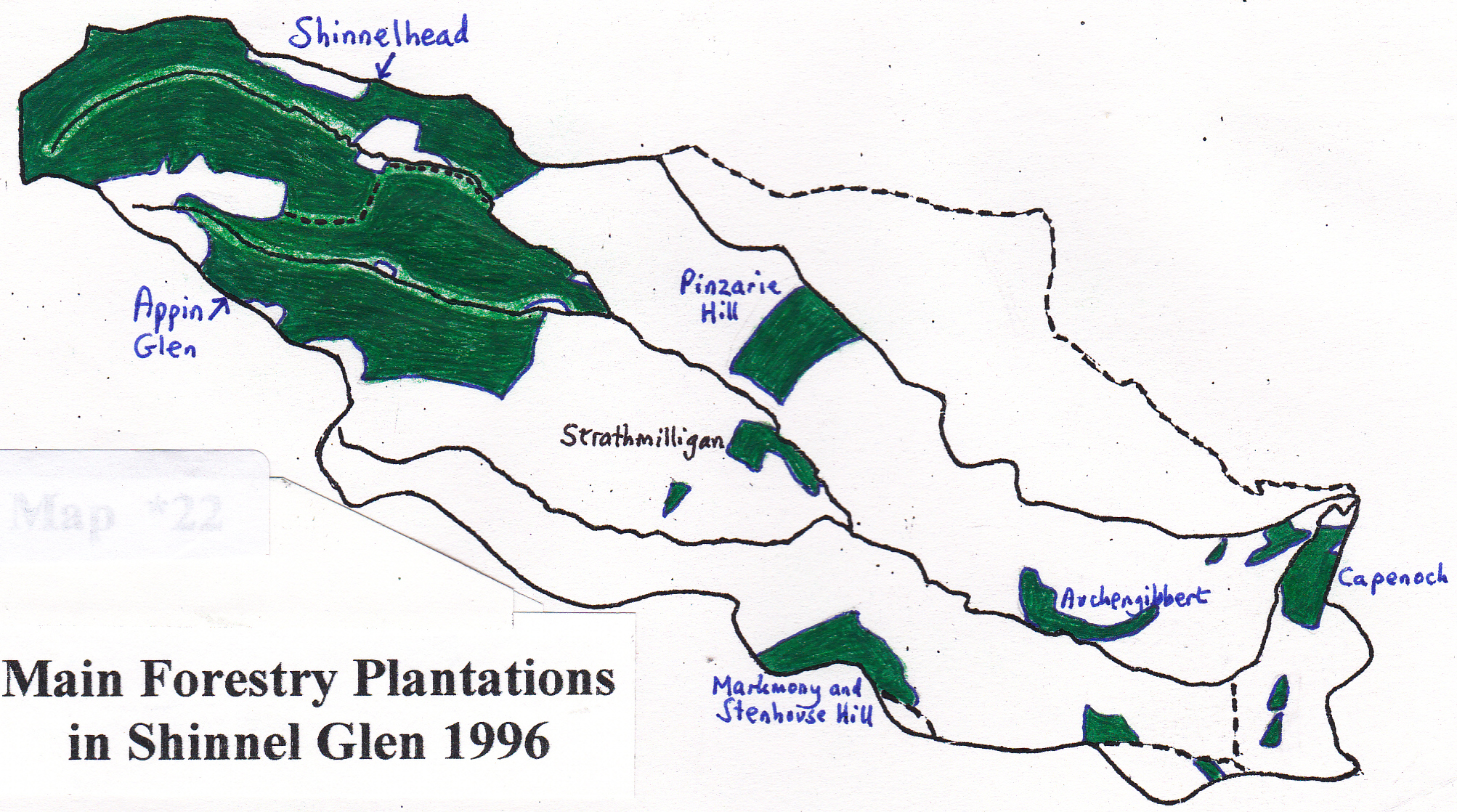
Tynron Glen was originally covered in forest, the removal of which is reminiscent of the situation in the Amazon Basin today. The soils have since degraded and this has been made worse by the large-scale monoculture of non-native species, causing acidification, ruin of water courses and use of chemical sprays. Larch and sitka spruce have taken over. The demand for these endless ranks of exotic softwoods is fed by our excessive use and waste of paper. I suppose this piece of work is a good example!
Asset-Stripping
In 1995 it was announced that the Forestry Commission was to sell off its 4,000 or so hectares of forest at the top of Shinnel, Dalwhat, Scaur and Euchan Glens, the Upper Nithsdale forests. This announcement has stirred up a hornets’ nest in Tynron. Conservationists, politicians and ramblers nationally are outraged. Opponents fear that this asset-stripping will affect the economy, wildlife and rights of access. People seem to prefer the Government running our large forests, rather than private enterprise.
All this timber is very soon due for clear felling. Tynronians had always assumed that the trees would be extracted via the Heads of the Valleys Road, emerging by Kirkconnel. This road was purpose-built by the Forestry Commission for extracting the timber.
However, now the forestry is to be sold in blocks, it is evident that the Shinnel block, at least, is likely to go down Shinnel Glen. There are potentially 48,000 loads of wood in these forests, plus 48,000 empty lorries going back up the glens.
The Government allows councils to spend extra money improving roads for the timber wagons and so the council is to upgrade the U400 road up the glen. They have started pre-emptive improvements in 1996 to allow the glen road to take the tremendous pounding expected from forestry vehicles up to 38 tonnes. The full lorries will be bad enough, but much of the damage is caused by the empty lorries bouncing back up the road. Naturally, local people do not want the glen road improved. If it stays as it is, then the large timber lorries will not be able to use it. One welcome improvement, however, has been the construction of passing places, although it is still difficult to see how two timber lorries can pass each other in some of these locations.
The Forestry Commission had the foresight to plan the Heads of the Valleys road, but nobody foresaw the Forestry Commission forests being outrageously sold off just before harvesting. Tynron folk do not want the timber trucks to knock the hell out of the glen road and undermine the foundations of roadside buildings. A solution might be to impose a clause in the extraction contracts compelling buyers to use the Heads of the Valleys Road.
Any buyer is sure to make a huge profit from the sale of the timber and afterwards gain large amounts in planting grants. All this is at the cost of so much discomfort and disruption to the local people, creating traffic problems, disturbing animals and ruining everyone’s peace and quiet. It always happens that for one person or financial organisation to make a killing, hundreds of other people must suffer.
Appin
In any case the private Appin forest is due to be felled from 1999 and the timber is bound to come down the glen. There have already been a few loads of thinnings, but up to twenty vehicles a day are expected at peak times in the summer. The sale notice for Appin Forest in November 1993 is reproduced here to show how much money there is to be made in forestry. Appin is now run by Shotton Forest Management, who have encouragingly put up “Walkers Welcome” signs. The two likely destinations for the timber are Irvine in Ayrshire and Shotton down in England on Deeside. If the wood goes north to Ayrshire, it is sensible to take the timber via the Heads of the Valleys Road. If the destination is Shotton, the Shinnel will be the economic route. I write this in December 1996, so by the time you read this things will have moved on. The council has just imposed weight limits on the glen road and there are protests that these forests are to be sold off at rock-bottom prices.
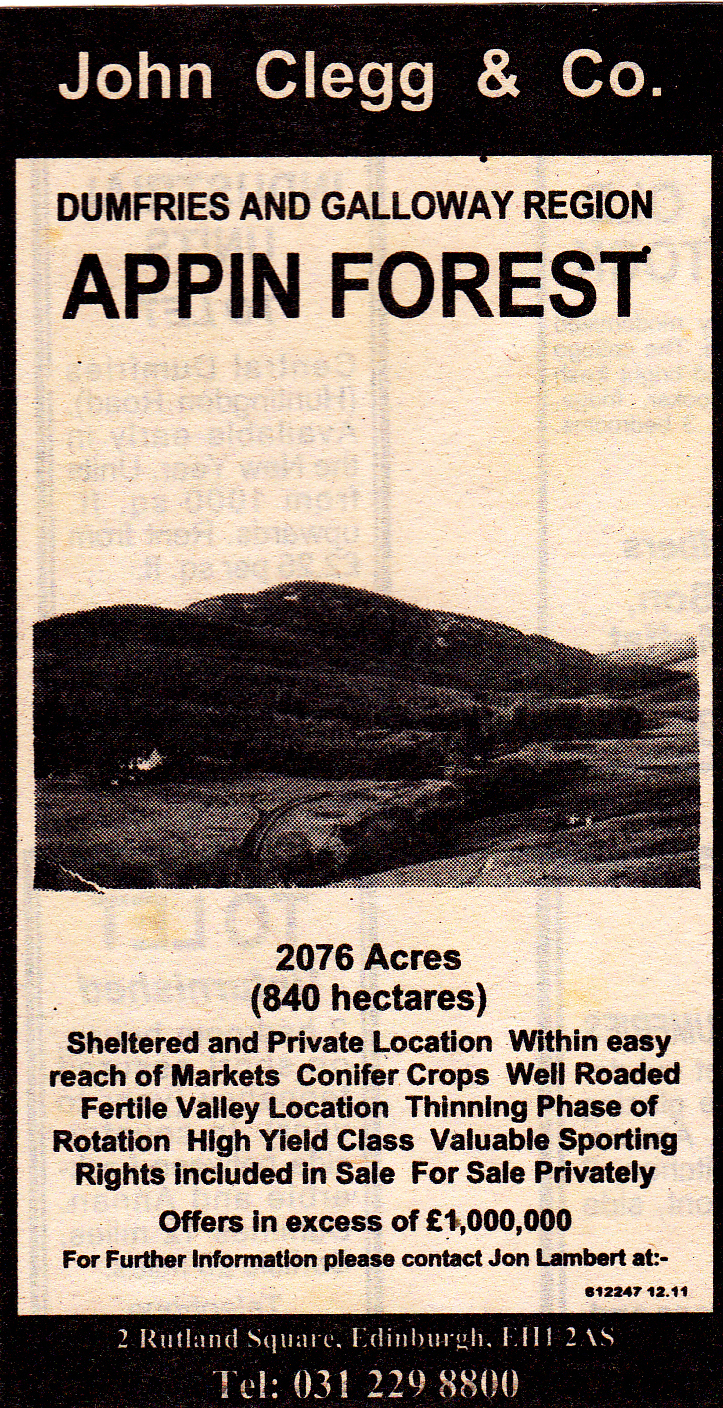
New Plantations
New forestry was planted in the mid to late 1980s on Pinzarie Hill and Stenhouse Hill by Economic Forestry. These plantings further down the glen are much more visible. Capenoch has also joined in this trend to plant over its poorer land. Unfortunately, the attractive area of Penfillan Moor has now been ruined by ditching and planting.
Before 1961 there were only small patches of plantation, amounting to a very small total area. The scenery of Shinnel Glen has been radically altered by the planting of so much new forestry. Thousands of hectares can be planted with, it seems to me, no restriction and no reference to the people who live in the glen. It is all done behind people’s backs. Open pasture becomes forestry on a large scale, yet a minor alteration to a house or the erection of a garden shed in Tynron Kirk requires so much paper work and red tape.
Forestry Grants
Forestry is being encouraged further by grants. Government incentives now are up to £1,350 per hectare for planting broad-leaved woodland. Just maybe, when Shinnelhead and Appin are replanted, native trees will be widely used and the present large rectangular blocks will be broken up to improve the scenery. The new forestry on Pinzarie Hill has quite a few hectares of broad-leaved trees on the hillside nearest the road. Unfortunately they have become a favourite food for deer and have not made too much growth in the first ten years.
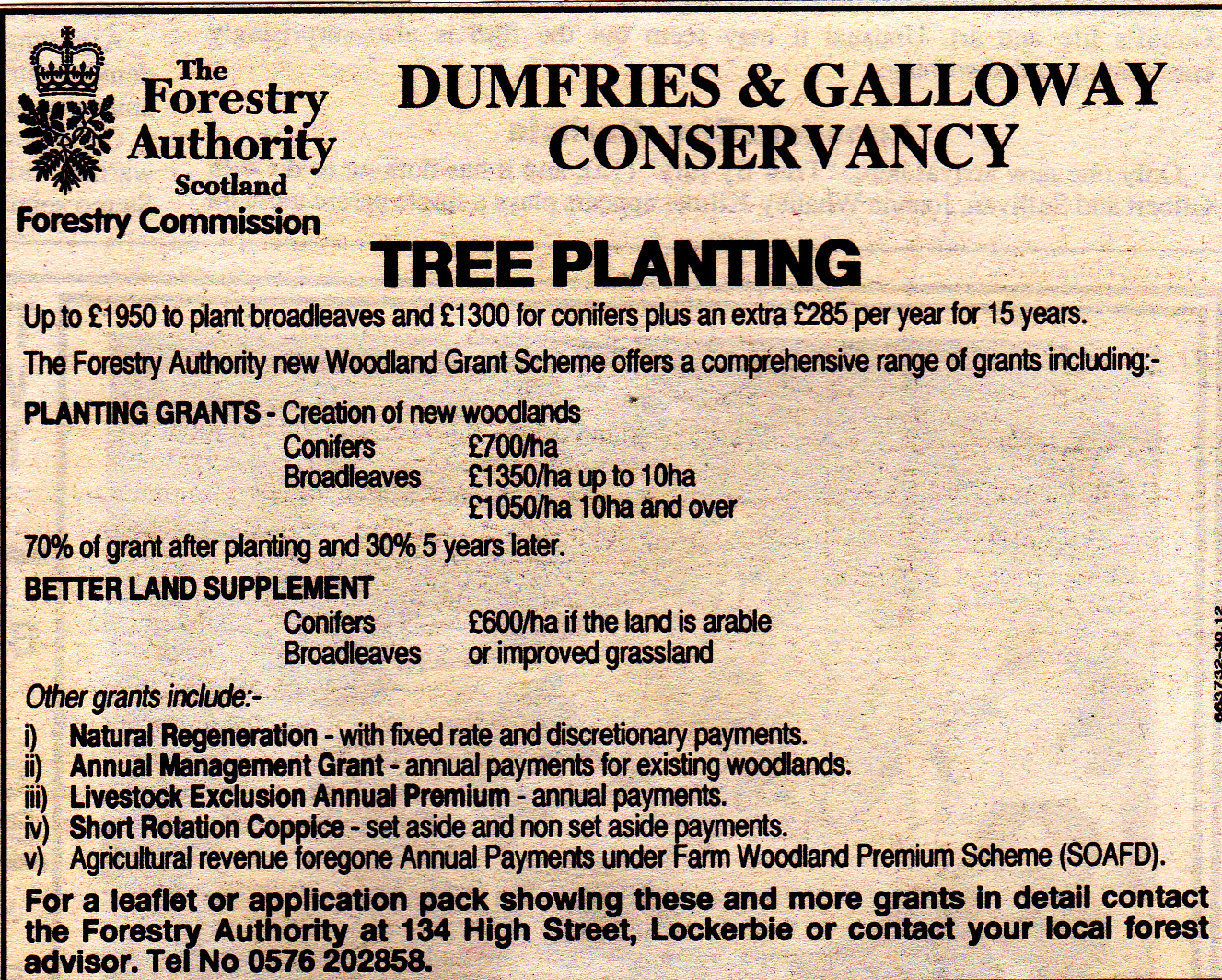
Woods
There are many small patches of semi-natural woodland in the glen, which are good for wildlife, but the most continuous strip is that along the Shinnel, which stretches right up to above Appin Lodge.
Around the big houses are some exotic and specimen trees. Some of the best examples extend along the drive to Shinnel Wood House, where there are very tall conifers in particular. The limes running down the road to Lann Hall gates are super.
Most farms have small, often long and narrow windbreaks of conifers. Because of their shape, these sometimes do not blend in too well with the scenery, but are often of Scots pine and provide shelter for stock and useful wildlife refuges.
There are also some sizeable patches of natural or semi-natural woodland:-
Stenhouse Wood
“Stenhouse Wood Wildlife Reserve” is the sign that now greets visitors to a wood, which is the nearest thing Tynron has to a natural wood. As it is on a steepish slope that receives a minimum of sun, it has been farmed very little in the past.
The late 1980s and early 1990s have brought work parties to Stenhouse Wood. On behalf of the Scottish Wildlife Trust these have rebuilt the boundary dykes to keep out farm stock. In the wood they have been doing judicious thinning and planting. One object has been to get rid of the sycamores, as they are not native species and can be a menace. They tried cutting them, then painting them with tree-killer, but the sycamores grew like the hydra’s heads.
Beech were also to be removed on the pretext that they are not native species. I am not so sure this is a good idea, as they are very beautiful and shade out the undergrowth, providing wonderful open space under their canopy. At least in early 1996 the beeches are still there. Beeches are the oldest and largest trees in the wood.
Oaks have been planted and there are many fine maturing oaks too. Parts of Stenhouse Wood are forests of ash saplings. The conifers had previously been harvested from the top of the wood. The wood is an SSSI (Site of Special Scientific Interest) and also contains wych elm, hazel, bird cherry, holly and hawthorn.
Tynron Juniper Wood
Though junipers were apparently common on Tynron hillsides in the nineteenth century, they are now decidedly rare, not only in Tynron, but anywhere in Scotland. It is clear from a photo that the junipers covered most of the Ford hillside around 1900. In the 1950s juniper covered too much of the hillside, right up to the Cairneycroft march, and Jim Gourlay started bulldozing it, following animals getting trapped.
So to conserve what remained, Tynron Juniper Wood was designated in 1958 as a National Nature Reserve, now run by Scottish Natural Heritage. It is very special and I hope the family at the Ford will continue to treasure it. Now there are about five hectares inside the fence and a considerable number of rather more damaged specimens on the adjacent hillside. Interestingly, what is now the finest juniper wood in Britain did not exist in 1853 (Buccleuch map) and counts of tree rings have confirmed that the oldest junipers are about that age. Most of the largest junipers are 80-120 years old, as juniper is very slow-growing.
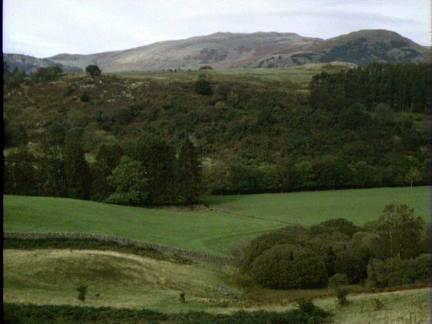
Tynron Juniper Wood from Barr Hill
This hillside is a real suntrap and contains other interesting trees like geans as well as a healthy population of birds, interesting mosses and three species of moth specific to juniper. Both columnar, up to a giant 7 metres, and sprawling bushy junipers are present. Heather and grasses are among the ground cover, but attempts are being made to clear bracken and bramble.
There was a fire in 1959, which destroyed about a hectare at the top, but it activated a terrific regeneration of junipers, suggesting that fire is the best thing for getting seeds to germinate.
There are a few more junipers on the top of Aird Hill and on Cairneycroft at 826932, amongst a good stand of broom, which would be better were it not open to farm animals. I have also spotted a solitary juniper by a crag up the hillside between Tynron Doon and Craigturra.
Juniper berries take two years to ripen and have many uses, like infusions, making gin, protection against plague and flavouring food, but may be perfectly well be eaten off the tree.
A leaflet is available from Scottish Natural Heritage at the Crichton, Dumfries, DG1 4UQ.
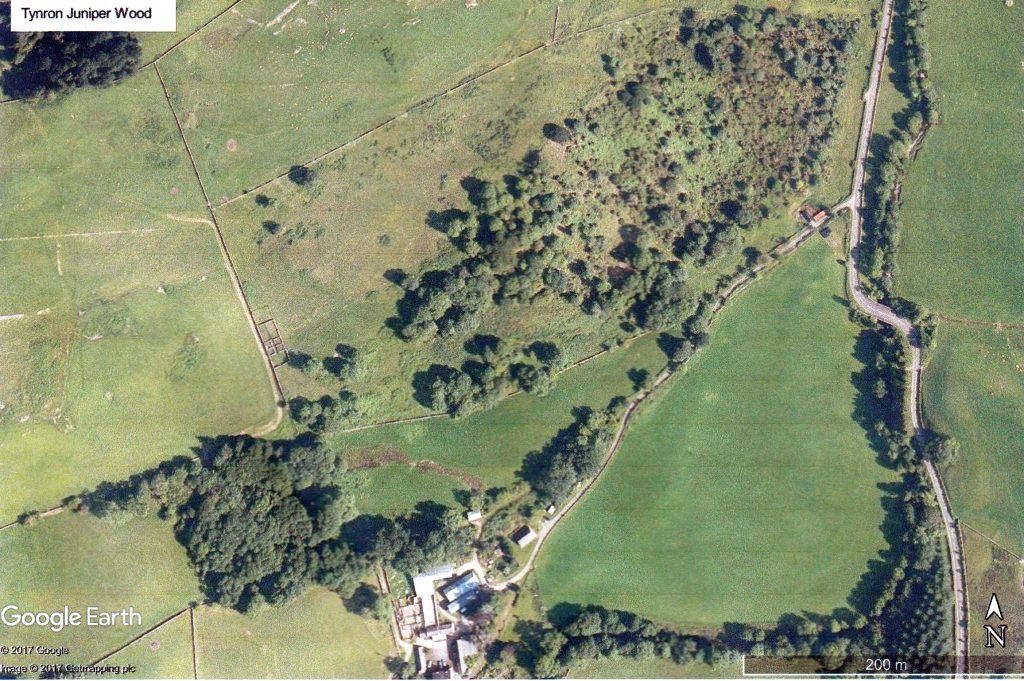
Tynron Juniper Wood and The Ford from Google Earth
Capenoch
In the lower part of the glen there are many fine oaks, none better than those in Longbank Wood on Capenoch around 837940. These are growing on a fine example of a river bluff. Above the wood is the best of the Shinnel’s river terraces. Capenoch is cutting a considerable part of its woods in Tynron Glen at the moment, but is leaving trees like oaks and birch to shelter the new plantings.
Lann Hall Wood
Lann Hall Wood at the top of the hill is quite open woodland in places, with extensive bracken in the lower half and more welcome heather in the top bit. It was still hill pasture in 1845, but was gradually abandoned last century. Planting took place in 1904/5, but there was a serious fire in 1909.
Gladstones are still doing some planting now. Encouragingly, some of this has been deciduous trees, but, discouragingly, it has been thought necessary to fill most of the remaining gaps with the dreaded sitkas and to plough first too. All this has led to the wood being rather a mixture and potentially a good wildlife reserve. It is a good place for shooting.
Pinzarie Wood
Pinzarie Wood is by the roadside and contains lots of birch. It is very very boggy and this is why it has remained woodland. It contains interesting plants and birds, but its drawback is that it has been regularly churned up by cattle kept there.
Auchengibbert Wood
Auchengibbert Wood is interesting. It contains some older deciduous trees as well as newer plantings. The scree slope below Craigturra contains some nice trees in rather inaccessible places. The old track up from Craigturra cottage to Auchengibbert can just be traced, at least in winter, starting in the quarry at the base of the scree slope, where the bottom bit of the track has been removed, then traversing diagonally up the slope and disappearing into the planted trees at the top.
Aird Wood
Aird Wood is another of the larger areas of woodland. It is mostly plantation, but if you are prepared to scrabble around by the crags, there are some wild trees.
Dutch Elm Disease
Dutch elm disease has reached Tynron. Some of the trees are clearly affected and may die quite quickly. The elms by Tynron Kirk bridge are badly affected now and will soon be dead.
Caterpillars
An interesting feature of the glen in summer is the fate of the bird-cherry, a common enough roadside tree. In May the bird-cherry is swathed in glorious white blossom, but in early summer it gets festooned in a substance akin to spiders’ webs. The culprits are little black caterpillars, which strip the trees of every leaf. The bird-cherry ermine moth lays its eggs in clusters among the small twigs. In spring the caterpillars feed and spin out a thick silk-like web as they go. Within this they are relatively safe, although I have seen blue tits taking them. By July the caterpillars have pupated and infected trees recover and set new leaves, which do not get eaten. The trees rarely fruit, however.
Lochs
Aird Loch
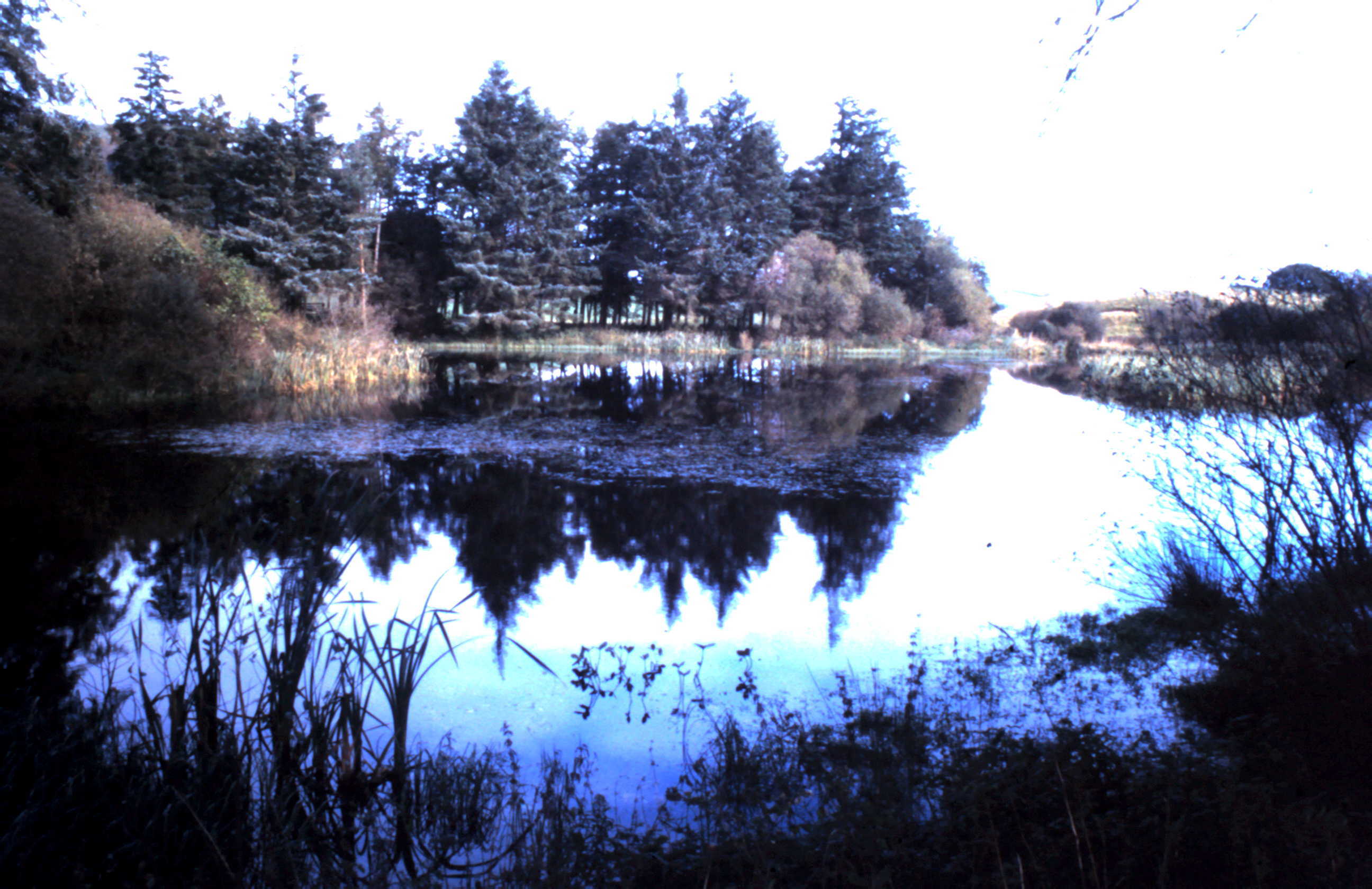
Aird Loch
Aird Loch was a very attractive spot, but is less so since most mature trees were removed in 1992. It occupies a natural hollow, but was enlarged by a small dam.
Capenoch Loch
Capenoch Loch drains into the Shinnel. I was told it was made in 1881 as a typical Victorian extravagance, a place to walk and watch or shoot waterfowl, but it was already on the 1850s OS map.
Kirkconnel Loch
Kirkconnel Loch was made in the early 1980s as a fishing loch by Maxwells. It is now beginning to mature for wildlife and has much pondweed.
The old loch at 753953 on Kirkconnel is a really beautiful spot, enhanced greatly by the shell of a Ford Anglia. This loch is often quite dry in summer.
The new forestry lochs at the top of Stenhouse and by Craigencoon attract some wildlife and one or two landowners have created small lochs for wildlife.
Flooding
Flooding is one of my pet hobby horses. Flooding has been greatly aggravated by man. Tynron Glen can take part of the share of blame for the flooding in Dumfries.
It is only natural for rivers to flood. That is how the river copes with a sudden excess of water after heavy rain. In trying to stop the river flooding, man has made things worse. The solution in the nineteenth century was to cut out all the Shinnel’s natural meanders and to straighten and deepen its course. The present course of the Shinnel is only where man has allowed it to be. The effect of this is that the water travels more rapidly down the river and out of the glen. The Shinnel scours its own bed more effectively, thus incising its course.
The effect on Dumfries of this happening in every glen in the Nith Valley is that a great surge of water arrives at Dumfries all at once and causes serious flooding. Formerly rain was soaked up by the hillsides and released slowly, spending a long time seeping down to the Shinnel. However, the combination of draining hillside farmland, encouraged by misguided Government grants, plus the side drains on the road, aggravated sorely by forestry ditches makes for very fast run-off. It has always surprised me that forestry ditches are ploughed up and down the hill, rather than along the contours. This must lead to rapid soil loss, all of which ends up silting up the rivers, aggravating flooding. I can see that the forestry people might need to drain small areas of land before planting, but otherwise I fail to see why the forestry ditching is done at all. It seems to be done automatically without thought for the consequences.
Although flood defences in Dumfries can be improved (and should have been while they were relandscaping Whitesands in 1996), the solution to Dumfries’s serious flooding is to be found in the upland glens. There should be enough land in every glen for the river to flood into. There are suitable stretches along the Shinnel which could be allowed to flood, thus enriching the soil on the floodplain with silt, instead of the silt being washed completely out of the glen. The blame lies with the farmers of the past thinking only of stopping the Shinnel flooding on their land. The cure also lies with the farmers of the present. What is wrong with the Shinnel flooding over farmland, if farmers have, as they do, plenty of warning from the weather forecasts in order to remove stock on low-lying land?
There should be a flood policy for the whole of the Nith catchment area and the latest news is that things are moving in that direction.
Rubbish
One of Tynron’s imperfections is the amount of rubbish to be found in the Shinnel and tributaries. Much of this can be blamed on farmers of the past, but now, when rubbish can be dumped very cheaply at Gatelawbridge or even collected by the Council for free, there is no excuse. All Tynron’s farmers are proud of their glen, but still there is some rubbish being disposed of in the easiest manner by dumping it in the river. It is a real eye-opener to walk up the Shinnel and see asbestos roofing, building rubbish, corrugated iron, barbed wire, large cans that once contained poisonous chemicals and any number of other items. You name it, it is there.
More than one farm has tipped the whole century’s rubbish, including fridges, cookers and washing-machines straight down the nearest bit of the river. Out of sight, out of mind. One farmer has removed some of the Shinnel’s last natural meanders by filling them in with farm rubbish such as machinery and old cars. Unfortunately this rubbish eventually gets washed down the river in storms. The prize for the best accumulation goes to the one 50 metres from the Stenhouse summer house, opposite Dalmakerran. Connoisseurs might also appreciate the cleughs by Bennan and Macqueston.
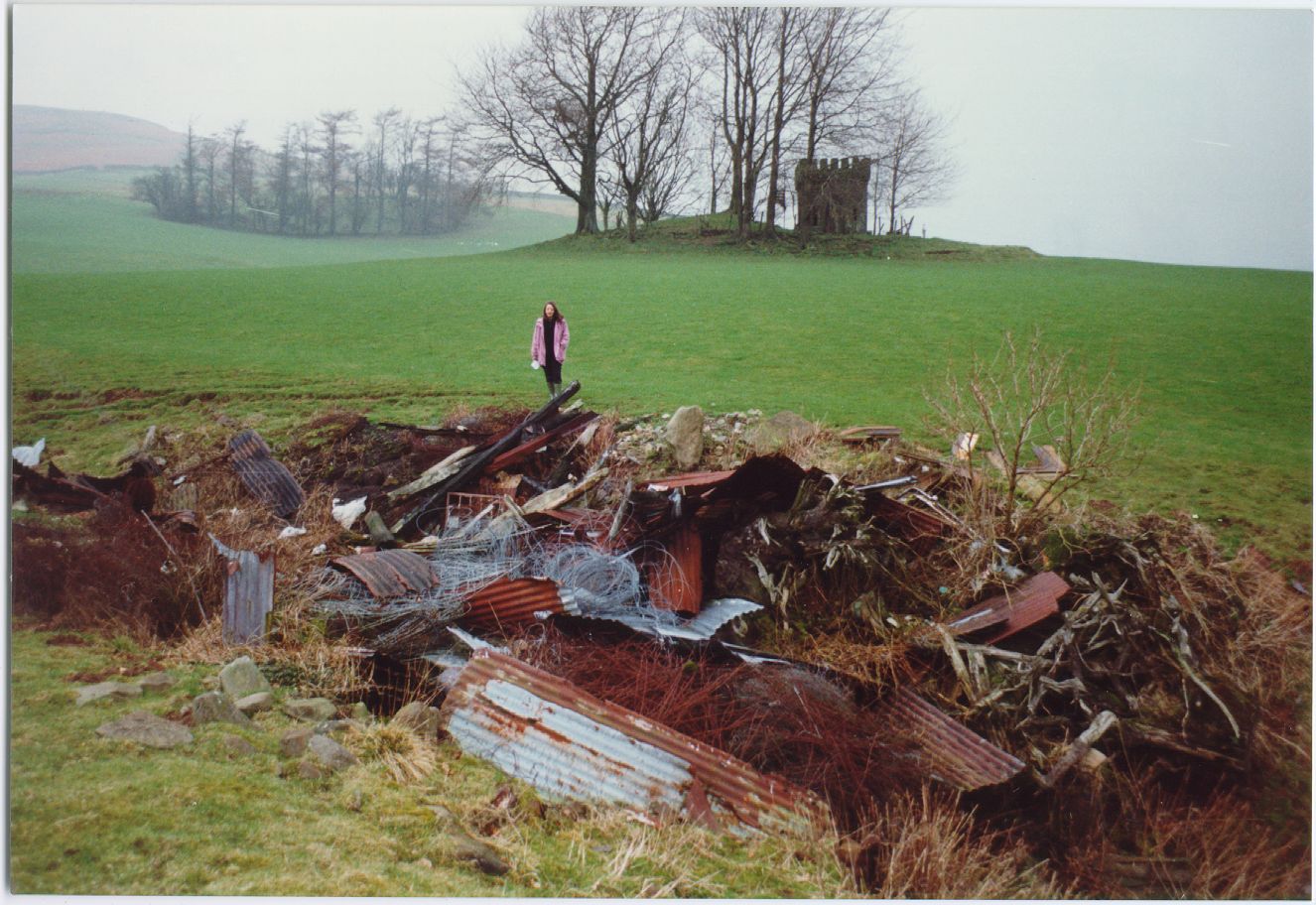
Tynron’s finest pile of rubbish. Stenhouse Folly in the background. Rebecca Shaw providing scale.
Pollution
I have seen slurry spread on fields beside the river and big-bale silage stored by the Shinnel and the poisonous liquid draining into the water. I have heard of sheep-dip being poured straight in, killing many fish. Chemicals from forestry and agricultural sprays end up in the Shinnel. Acid rain and road salt don’t help. It is a wonder there are any fish.
Even in 1876 three children of Thomas Gray, the blacksmith at Parkhouse, were poisoned, having drunk water from The Pen, the ditch running from Dalmakerran steading. One died and two were very ill.